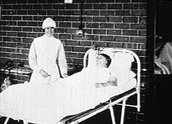

Austin Hospital at Heidelberg, Vic: The Only Hospital for Chronic Diseases in Australia (1928)
Synopsis
This silent documentary shows the Austin Hospital at Heidelberg in Victoria including its extensive grounds; its main buildings and wards; patients undergoing ‘sun-treatment’ in the gardens; and the nursing staff. It includes descriptive intertitles that identify each building and ward.
Curator’s notes
Beautifully photographed and comprehensive in its coverage of the hospital grounds and facilities, this documentary vividly captures the progressive work that the Austin Hospital was doing in the 1920s. Six patient wings are shown that, in total, house almost 300 patients. As well as documenting the hospital’s physical grounds and wards (some of which no longer survive), it also shows the patients. Patients are wheeled out in their beds onto the outside verandas (see clip one) and cancer patients taken out into the sunshine for ‘sun treatment’.
At the time this documentary was filmed, the Austin Hospital was the only hospital for chronic diseases in Australia. It treated patients with tuberculosis as well as patients with illnesses then thought to be incurable, such as cancer. The hospital was first established in 1882 in the outer Melbourne suburb of Heidelberg and by the 1920s began experimenting with X-ray treatment for cancer patients (an example of the X-ray implements can be seen in clip two. The hospital in the 1920s also had a small children’s wing and lodges for the nursing staff.
Austin Hospital at Heidelberg was directed by WJG Turner and produced by Australasian Films for the Austin Hospital. It was probably used to promote the work that the hospital was doing at the time. It is a vivid record of the hospital’s history.


